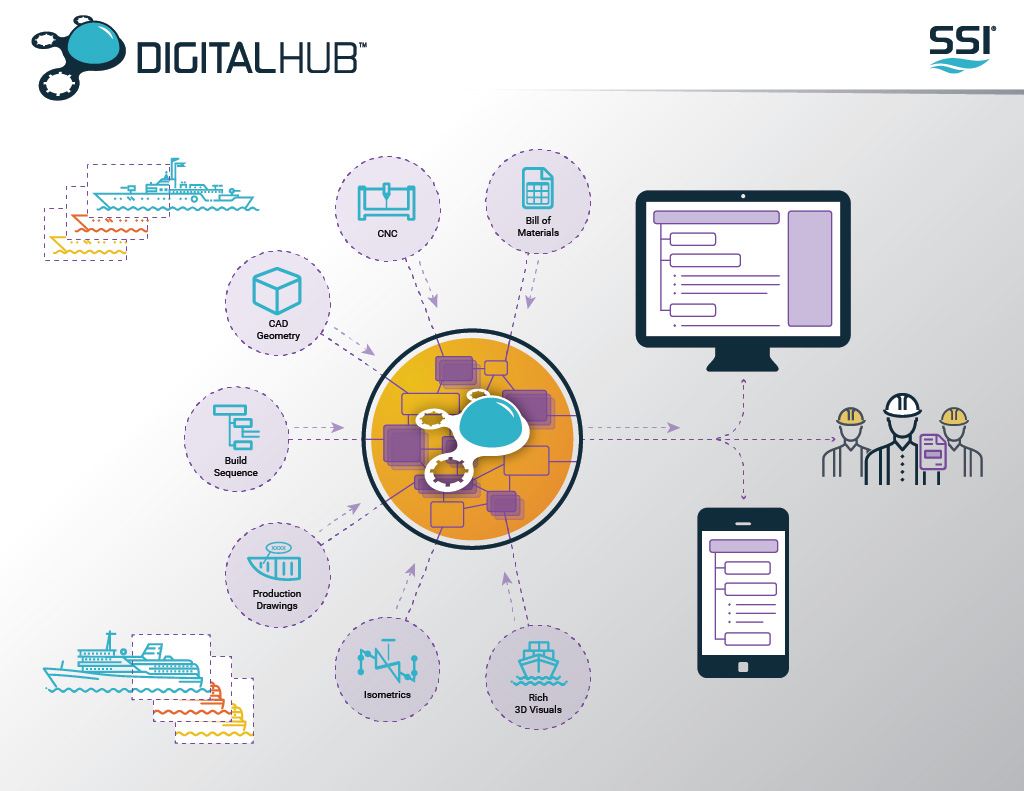Shipbuilding requires precise coordination among many departments – but too often, critical information is siloed outdated legacy systems and spreadsheets. An integrated system designed specifically for the shipbuilding industry, such as SSI Shipconstructor, offers a practical and organized flow of information for Engineering, Planning, Production, and Project Management teams. This enables organizations to fully leverage the massive amounts of data generated throughout the shipbuilding process.
For essential activities like change management workflows, design reviews, and progress tracking, it’s crucial to maintain into evolving project data. From managing CAD drawings and 3D models to tracking changes across assemblies, spools and parts, organizations must be able to maintain historical snapshots control documentation releases, and ensure production teams are always working from the most current and accurate data.
A successful shipbuilder’s information management solution will:
- Have pre-configured data with item types including Parts, Assemblies, Drawings, Spools, Systems, and Nests.
- Be ready out of the box to show engineering, planning, and production teams the information that matters most to them.
- Have web-based access so that applications don’t need to be installed on users’ desktop computers.
- Support information browsing on a tablet computer from anywhere in a shipyard.
- Allow for all data to stay local, mitigating risks and allowing for more control over where the data is accessible.
- Extend to work with powerful shipyard management workflows.

Breaking down the silos of legacy software, spreadsheets, employee knowledge, and disconnected engineering software is what allows every department to access the information they need. Organizing that information in a way that maintains coordination across departments, is designed for the requirements of shipbuilding, and is practical for the needs of Engineering, Planning, Production, and Product Management is crucial.
No matter how fragmented the current shipyard system architecture may be, as a foundational platform, DigitalHub provides immediate return from a small initial investment and can be further customized to satisfy the specific needs of any shipyard. From managing CAD drawings to 3D models, DigitalHub offers a scalable, flexible solution whether you’re building submarines, commercial vessels, or engaging in ship repair and maintenance.
Seamless Integration with ShipConstructor
To make informed decisions going forward, it’s important to know a project’s current and past status. DigitalHub works by capturing the evolution of your ShipConstructor projects through time. Simply by using a standard web browser to view ShipConstructor items and their relationships, accurate data becomes easily accessible to users across all shipyard departments.
DigitalHub can be used immediately because it is pre-configured with ShipConstructor item types including:
- Parts
- Assemblies
- Drawings
- Spools
- Nests
ShipConstructor data is gathered into DigitalHub through EnterprisePlatform and is recorded as a data snapshot at a point in time. As your ShipConstructor project data changes, these can be periodically imported into DigitalHub to create the most current view of the data, as well as provide historical snapshots and change lists through time.
Secured Locally, Accessible from Anywhere
Especially for global organizations, being able to access the same information from anywhere is key to removing silos. Access to DigitalHub is web-based, so it does not require any applications to be installed on users’ desktop computers. DigitalHub is powered by the Aras Innovator PLM that uses standard Microsoft SQL Server and IIS technologies, meaning that your data stays local and accessible.
